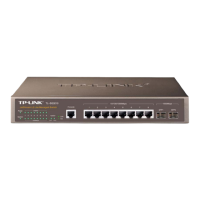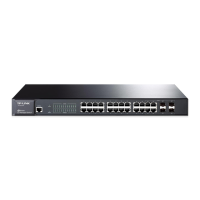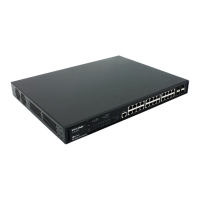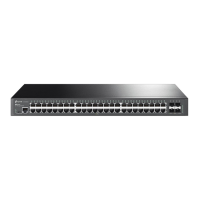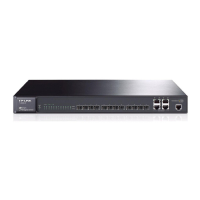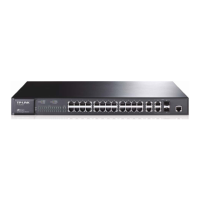Do you have a question about the TP-Link JetStream TL-SG3210XHP-M2 and is the answer not in the manual?
Details the switch's features, wire-speed performance, L2 management, and security strategies.
Illustrates the front panel layout of various JetStream switch models.
Explains the function and indication of various LEDs on the switch.
Describes the function of Console Port, RJ45 Ports, and SFP/SFP+ slots.
Details the Kensington Security Slot, Grounding Terminal, and Power Socket on the rear panel.
Lists the items included in the switch package, advising to contact distributor if items are missing.
Provides essential safety rules to prevent device damage and bodily injury during installation.
Lists the necessary tools for installation, noting they are not included with the product.
Guides through desktop and rack installation procedures for the switch.
Explains how to connect an Ethernet port of the switch to a computer using an RJ45 cable.
Demonstrates the process of inserting an SFP/SFP+ module into the corresponding slot.
Details connecting PCs or Terminals to the console port for switch management via CLI.
Lists items to check after installation, including ventilation, power, grounding, and connections.
Instructs on connecting the power cord and powering on the switch, ensuring correct voltage.
Describes the Power-On Self-Test process and LED indicator behavior during initialization.
Presents two configuration options: Standalone Mode and Controller Mode for switch management.
Explains configuring the switch individually using GUI or CLI.
Details managing multiple network devices centrally using Omada Software/Hardware Controller or Cloud-Based Controller.
Provides steps to recover lost username and password via the console port and bootUtil menu.
Troubleshoots issues with the PWR/Power LED, checking cable connection and voltage.
Offers solutions for accessing the web management page, including checking LEDs, cables, IP settings, and factory reset.
Helps resolve issues with the terminal emulation program display, checking cable and program parameters.
Lists the various IEEE standards supported by the switch models.
Details the supported transmission media types and cable specifications for different ports.
Provides a list of LED indicators for each switch model and their functions.
Specifies operating and storage temperature and humidity ranges for the switch.
Details the switch's features, wire-speed performance, L2 management, and security strategies.
Illustrates the front panel layout of various JetStream switch models.
Explains the function and indication of various LEDs on the switch.
Describes the function of Console Port, RJ45 Ports, and SFP/SFP+ slots.
Details the Kensington Security Slot, Grounding Terminal, and Power Socket on the rear panel.
Lists the items included in the switch package, advising to contact distributor if items are missing.
Provides essential safety rules to prevent device damage and bodily injury during installation.
Lists the necessary tools for installation, noting they are not included with the product.
Guides through desktop and rack installation procedures for the switch.
Explains how to connect an Ethernet port of the switch to a computer using an RJ45 cable.
Demonstrates the process of inserting an SFP/SFP+ module into the corresponding slot.
Details connecting PCs or Terminals to the console port for switch management via CLI.
Lists items to check after installation, including ventilation, power, grounding, and connections.
Instructs on connecting the power cord and powering on the switch, ensuring correct voltage.
Describes the Power-On Self-Test process and LED indicator behavior during initialization.
Presents two configuration options: Standalone Mode and Controller Mode for switch management.
Explains configuring the switch individually using GUI or CLI.
Details managing multiple network devices centrally using Omada Software/Hardware Controller or Cloud-Based Controller.
Provides steps to recover lost username and password via the console port and bootUtil menu.
Troubleshoots issues with the PWR/Power LED, checking cable connection and voltage.
Offers solutions for accessing the web management page, including checking LEDs, cables, IP settings, and factory reset.
Helps resolve issues with the terminal emulation program display, checking cable and program parameters.
Lists the various IEEE standards supported by the switch models.
Details the supported transmission media types and cable specifications for different ports.
Provides a list of LED indicators for each switch model and their functions.
Specifies operating and storage temperature and humidity ranges for the switch.
| PoE+ Ports | 8 |
|---|---|
| PoE Power Budget | 240W |
| MAC Address Table | 16K |
| Jumbo Frame | 9 KB |
| Packet Buffer | 4 MB |
| Standards and Protocols | IEEE 802.3, IEEE 802.3u, IEEE 802.3ab, IEEE 802.3x, IEEE 802.1Q, IEEE 802.1p, IEEE 802.1D, IEEE 802.1S, IEEE 802.1W, IEEE 802.3ad |
| Dimensions | 440×230×44mm (17.32×9.06×1.73in) |
| Operating Temperature | 0°C to 50°C |
| Storage Temperature | -40°C to 70°C |
| Operating Humidity | 10% to 90% (Non-condensing) |
| Storage Humidity | 5% to 90% (Non-condensing) |
| Power Supply | 100-240 V AC~50/60 Hz |
| Ports | 8× 10/100/1000 Mbps RJ45 ports, 2× 10G SFP+ slots |
| Layer | Layer 2+ |
